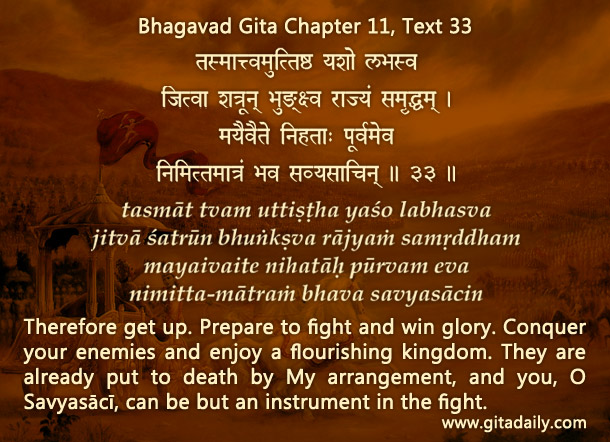Some people say, “The Bhagavad-gita’s statement that the world is a place of misery makes people fatalistic, passively accepting atrocity.”
If the Gita were fatalistic, why would it ask Arjuna to take assertive action against the atrocious Kauravas?
Even the Gita verse about the world’s ephemerality and misery (08.14) mentions these features as a passing reference. That verse’s stress is on dharma, specifically on the supreme dharmic practice of bhakti-yoga, as a means for transcending this world.
Gita wisdom explains that we all are at our core souls. We can achieve lasting happiness only by developing our spiritual relationship with the all-attractive Absolute Truth, Krishna. For facilitating such spiritual growth, a basic level of social order or dharma is essential. To establish dharma, God himself descends (04.07-08). And he even asks his devotees to assist in that mission of establishing dharma. He urges Arjuna to embrace his dharmic duty as a warrior in a devotional mood and assures him of victory (11.33).
Nowhere does the Gita use the world’s distressful nature to imply that victims of atrocities be fatalistically passive. What about its asking us to tolerate life’s dualities (02.14)? This call for tolerance arises not from fatalism, but from hard-eyed realism – the unsentimental acknowledgment that the world’s dualities subject everyone to misery. Moreover, that tolerance is not a call for passivity – it is a call for focusing on the practice of dharma for attaining transcendence (02.15). Gita wisdom recognizes that we need to sometimes tolerantly avoid certain battles, and sometimes assertively fight certain battles. The deciding criterion is how we can best practice our dharma individually and best aid in establishing dharma socially.
Thus, the Gita centers not on fatalism but on dharma – and for promoting dharma, it endorses both tolerance and activism.
To know more about this verse, please click on the image
Explanation of article:
Podcast:


Leave A Comment